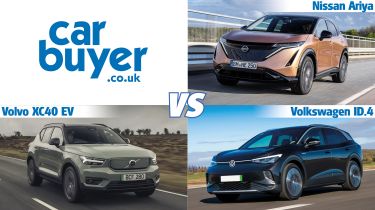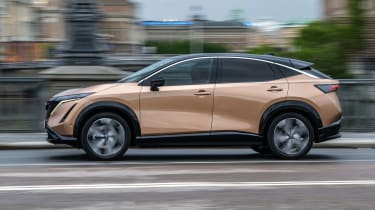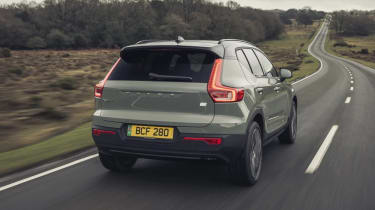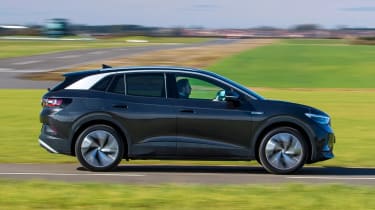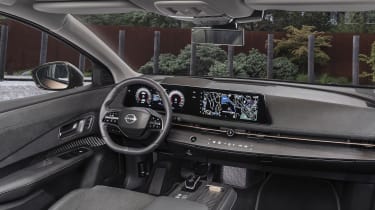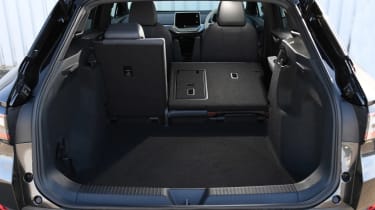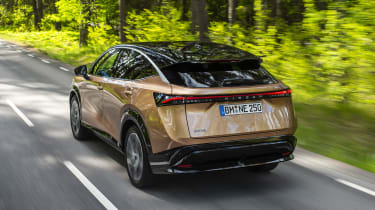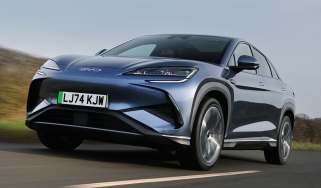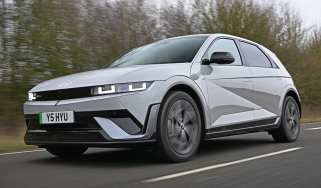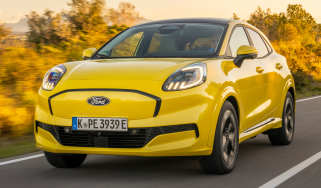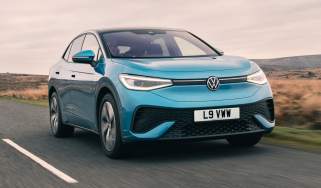Nissan Ariya vs Volvo XC40 vs Volkswagen ID.4 - which is best?
Three practical electric family SUVs – but only one can be our winner
Over the past few years, electric SUVs have become almost as much of a status symbol as a designer handbag or a pair of posh wireless headphones. Yet in becoming a fashion item, it’s easy to forget what has made these vehicles so popular in the first place; electric SUVs are more practical than their saloon and hatchback counterparts, while also offering significantly reduced running costs over the equivalent petrol or diesel car.
 Top 10 best electric SUVs – the ones to buy in 2025
Top 10 best electric SUVs – the ones to buy in 2025
However, as the electric SUV market continues to expand, it can be difficult to know which models to consider. There are so many options to choose from, all coming in different shapes and sizes and offering confusing-sounding range figures that may as well be an algebraic equation to the average car buyer.
We’ve taken out the guesswork by picking three of the best electric family SUVs on sale right now – the Nissan Ariya, the Volvo XC40 Recharge and the Volkswagen ID.4 – and compared them to see which is best. While we have not driven them side-by-side, we have in-depth reviews of each model if you wish to learn more. Keep reading to see which we think is best.
Which has the best range and charging capability?
Range is typically a buyer's main concern when making the switch to an electric car. EVs aren’t quite as straightforward to fill up as their petrol and diesel counterparts, leading to anxiety surrounding whether you’ll have enough charge to complete your journey.
Thankfully, all three cars here can travel a significant distance before needing to be plugged-in. The Volvo XC40 Recharge may have the shortest range of the trio – owners can expect to travel up to 258 miles on a single charge – but it should be more than enough for most buyers day-to-day. On longer journeys, the XC40 Recharge can plug-in at an ultra-rapid 150kW public charger, and top up from 10-80% in under 40 minutes.
Unlike the Volvo, the Nissan and Volkswagen are both available with multiple battery setups that offer varying amounts of range. The entry-level Ariya utilises a 63kWh battery and, just like the Volvo, can do around 250 miles on a single charge. However, Nissan also offers its electric SUV with a larger 87kWh battery, allowing it to travel 310 miles before needing to be plugged-in – perfect for those looking to travel longer distances frequently. Both versions of the Ariya can charge at speeds of up to 130kW, allowing for a 20-80 per cent top up in less than 30 minutes.
On paper, the Volkswagen ID.4 can travel the furthest distance on a single charge: up to 323 miles, depending on wheel size and exact specification. However, this is only achievable on top-spec Pro Performance cars; the entry-level Pure only gets a 52kWh battery with a maximum range of 223 miles. Despite having the longest range, the VW does have the slowest maximum charging speed; with a 125kW maximum charging capacity, owners can add around 200 miles of range in half an hour when connected to a compatible public charger.
Which is the most comfortable?
UK roads are far from the smoothest in the world; with the amount of potholes and speed bumps around, cars need to have supple suspension in order not to shatter the spines of their occupants.
The Volkswagen ID.4 deals with the majority of road imperfections well; cars fitted with the standard suspension setup soak up most bumps, however larger potholes have a much more intrusive effect. Top-spec models can be optioned with adaptive suspension which can be made softer for a more relaxing ride.
The Volvo and Nissan are even more comfortable. Both have been designed to waft down the road and are fitted with soft suspension as a result. A light steering setup means neither car is a chore to manoeuvre around town and the lack of a noisy engine means the Ariya and XC40 Recharge are much more relaxing to travel in than their petrol or diesel counterparts.
Which is the most fun to drive?
At face value, an electric SUV sounds pretty boring to drive; the lack of sound from the electric motors is hardly as visceral as the growl of a combustion engine and the added weight of the batteries mean most EVs can weigh over two tonnes. However, their inherent low centre of gravity and punchy powertrains result in an electric car being much more exciting than you might think.
A good example of this is the Volvo XC40 Recharge; while it has been designed first and foremost to offer the most relaxing driving experience possible, it can still provide some elements of fun. Entry-level single-motor models produce a healthy 228bhp, whereas top-spec dual-motor cars boast a muscular 402bhp – more than a Porsche 911 Carrera!
The Nissan Ariya is also primarily set up for comfort, however the Japanese brand’s engineers have also managed to make it relatively fun to drive on a twisty road. The Ariya’s steering is well-balanced (if a tad lacking in feel), with the ‘Sport’ mode tightening things up even further. There are two electric motor setups to choose from: a single, front-mounted unit with 239bhp or a dual-motor all-wheel-drive layout with 302bhp. With the latter configuration, the Ariya can get from 0-62mph in 5.7 seconds, yet it feels even faster thanks to the instant torque provided.
However, it's the Volkswagen that will provide the greatest zero-emission thrills of the trio. All versions of the ID.4 are great fun to drive as body roll is kept to a minimum and the steering is nice and direct. However, it’s the range-topping GTX model that sets the ID.4 apart from the rest; this has a dual-motor all-wheel-drive setup with 295bhp and can get from 0-62mph in 6.9 seconds. GTX cars also get a sportier suspension setup for even tighter handling, with a 15mm lower ride height.
Which has the best interior?
While it’s important to like how your car looks from the outside, it’s crucial to like your car’s cabin as this is where you’ll spend the most time. Volkswagen has built a reputation for producing quality products, however the interior of the ID.4 can’t quite keep up with rivals. The minimalist design is certainly attractive, however plenty of cheap-feeling trim really lets the ID.4 down. Volkswagen’s latest infotainment system is also somewhat of a disaster to use; despite being an all-new setup, it can be incredibly laggy and difficult to navigate.
Things get better in the Volvo XC40 as the Swedish brand has taken its signature Scandinavian approach to minimalism, with plenty of luxurious materials and an eye-catching portrait-style central infotainment screen. This comes as standard on all trim levels and is powered by Google software.
Surprisingly, it’s the Ariya that is the most pleasant car to sit in. Nissan isn’t exactly known for its high-quality interiors; the majority of the brand’s models have cabins that are best described as ‘functional’ than anything else. The Ariya however, is a completely different ballgame as everything you touch feels exceptionally premium. The Ariya pays homage to its Japanese heritage with several ‘easter eggs’ dotted throughout the cabin and Nissan’s latest infotainment system represents a huge improvement over ones of old; it’s incredibly easy to use and while the screen isn’t quite as sharp as rivals, it responds quickly to your inputs.
Which is the most practical?
In a world of impractical coupe-style crossovers, it's not always a given that this type of car will offer the ‘Utility’ that the ‘SUV’ name suggests. Having said that, all three of these SUVs should offer ample space for you and your family.
The Nissan Ariya’s boot measures at 466 litres, however this shrinks to just 408 litres on dual-motor cars. While it should be enough to carry the majority of prams or a couple of suitcases, the Ariya may not be the best choice if you plan to haul large items often. What the Nissan does excel at, however, is passenger space; the Ariya gets a nifty sliding centre console which can prioritise foot space in either the front or rear of the car.
Next up is the Volvo XC40 which has the smallest boot here, providing just 452 litres of cargo space in the rear – this doesn’t shrink for all-wheel-drive cars, though. Yet, the real ace up the XC40’s sleeve is its front boot (also known as a ‘frunk’) which offers an extra 32 litres of storage under the bonnet. Thanks to its boxy shape, the XC40 Recharge feels roomy in the cabin, with plenty of head and legroom for rear passengers.
If you’re after practicality above anything else, it's the Volkswagen ID.4 that offers the most in terms of sheer space. While it doesn’t have a useful ‘frunk’ under the bonnet, the VW’s cavernous 543-litre boot should more than make up for that. The ID.4 is incredibly spacious inside, too; adults will have more than enough space sitting in the rear seats, let alone children. However it's worth noting the mechanically-similar Skoda Enyaq iV will offer even greater versatility.
Which should you buy?
No matter which you choose, all three of these SUVs offer plenty of everyday usability and are an ideal first step into the world of electric motoring. The Volkswagen ID.4 is living proof that EVs can still be fun to drive, whereas the Volvo XC40 Recharge demonstrates how an electric powertrain can make a car even more relaxing to travel in.
But, it’s the Nissan Ariya that gets our vote here. The Nissan brand may not have the same kerb appeal as either Volvo or Volkswagen, but the Ariya undeniably feels the most premium car here. Nissan has managed to surpass even Volvo in terms of interior design and quality and while the Ariya may not be as sporty as the Volkswagen, tight handling isn’t usually the top priority for SUV buyers. The Nissan Ariya is a stellar first-attempt at an electric SUV for the Japanese marque and shows that it hasn’t lost its knack for building good EVs after the success of the Leaf hatchback.
Not sure if you want an SUV but want to keep running costs low? Check out our list of the top 10 best electric family cars
Recommended
Most Popular

New Smart #5 Brabus is a 637bhp far cry from the brand’s city car past

Best car leasing deals 2025: this week’s top PCH offers
Tips & advice

Car dashboard warning lights: what does each symbol mean?

Electric car charging stations: public networks, charger types, apps and maps


